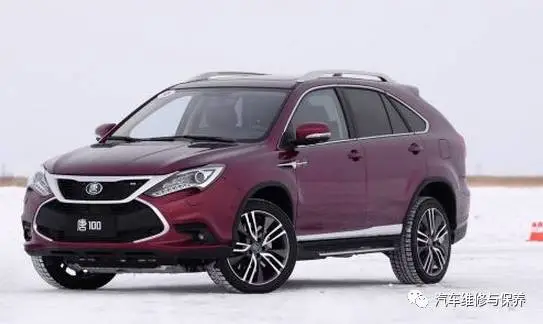

◆ text/Guangdong Wang Guixing
Failure phenomenon
A 2017 BYD Tang hybrid electric vehicle has a power source of 2.0TI turbo charged engine and two three-phase permanent magnet synchronous drive motor. The 712v ferrous phosphate lithium battery of 26Ah is equipped with a 6-speed wet dual clutch transmission with a pure electric endurance range of 80km. It is environmentally friendly and saves gasoline costs. It is very suitable for urban residents' travel and office workers.
One day after the vehicle was just charged, it suddenly failed to drive in the electric mode, and a warning of "Please check the power system" appeared in the center of the dashboard (Figure 1). At this time, the SOC index of power storage was marked as 98%, it indicates that the vehicle has been fully charged, and it should be preferentially driven by electric mode. Why can't the vehicle start? At that time, we had to switch the electric "EV" mode to the hybrid "HEV" mode. Fortunately, the engine could still start and the vehicle could still drive. Then try to switch to electric mode, and the vehicle cannot run. This proves that there is indeed a problem with the electric mode of the car.
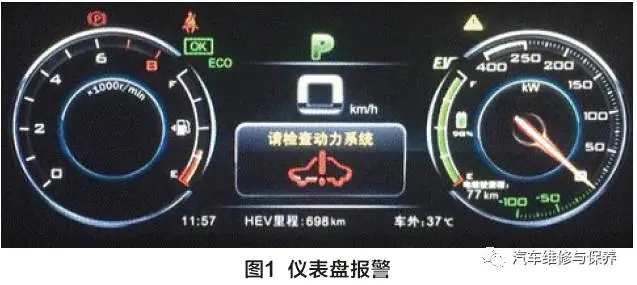
Fault diagnosis and remove
This car is an electric four-wheel drive, which has three kinds of driving power, namely the engine, front motor and rear motor, among which the front motor drives the front axle and the rear motor drives a rear axle, with the engine, real-time mode is adopted, which can be flexibly changed into precursor or four-wheel drive. In the aspect of driving mode, there are two modes of EV electric and EV oil-electricity mixing, and they are divided into two driving types: economy and sports. The former is more economical and fuel-efficient, while the latter has strong power acceleration ability. Two drive motor are directly mounted on the front axle and a rear axle. It can be seen from this that the control system of electric four-wheel drive Tang car is relatively complicated. The detection data flow from Fig. 2 shows that the front motor is in the state of being off and unable to drive, which indicates that it cannot be driven in EV mode.
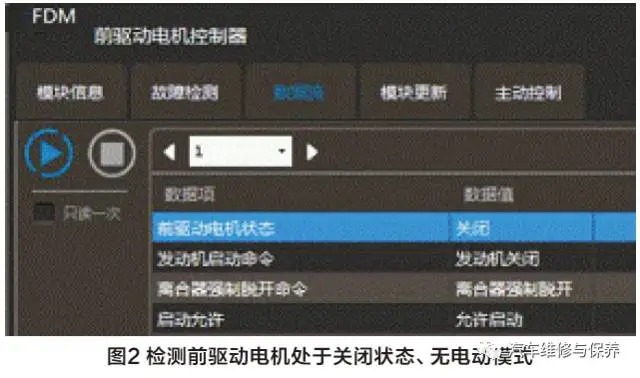
1. Failure Analysis of "check power system"
According to the prompt "check power system" on the dashboard, find the reason why it cannot be switched to the electric EV mode, and call up the fault code of the computer BMS of the car. There are two faults: one is P1A3400, the meaning is the failure of "pre-charging failure"; The other is P1C0500, which is the failure of "high voltage undervoltage of rear drive motor controller" (Figure 3).

(1) analysis of "precharge failure" and "high voltage Undervoltage" faults
Considering the situation that the power battery is fully charged, it is preliminarily judged that the voltage of the power battery should be normal. Considering "pre-charging failure" and "high voltage Undervoltage", it is necessary to analyze whether the negative contactor, pre-charging contactor, main contactor contactor and partial voltage Contactor of power battery system can be absorbed? This involves the question of whether the vehicle can be "powered on" normally. Of course, it involves high-pressure distribution box, BMS control system, front and rear drive motor frequency conversion control system, which indicates that the failure is relatively hidden. Figure 4 shows the power system construction drawing of the car. It can be seen from the figure that the power battery passes through the high-pressure distribution box, forward and rear motor controllers to realize four-wheel drive. At the same time, it also supplies power to air conditioning compressor, etc., and the power of the engine can also be driven by the front wheel. The power battery is controlled by the battery manager through high-pressure distribution box.
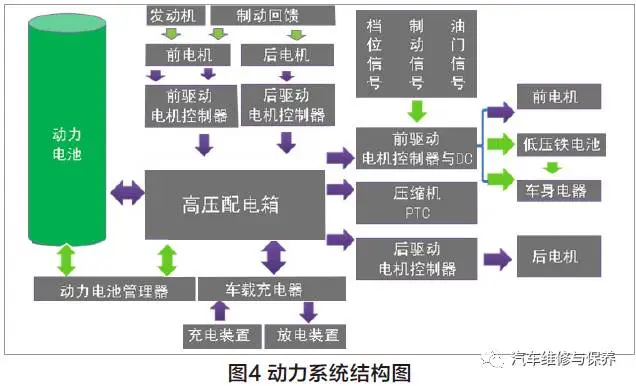
(2) maintenance of power-on high-voltage battery
The so-called "power-on" means to input the voltage of the power battery to the vehicle. Only after the normal "power-on", drive controller can input the DC high voltage of the power battery and supply drive motor qualified three-phase alternating current with frequency conversion, only the motor can rotate to generate power, otherwise the vehicle cannot be driven normally by the motor.
The operating system of "power-on" Electric vehicles uses a voltage of 12V, which is powered by small batteries. This small battery is not a traditional lead-acid battery, but a lithium battery with stronger power storage capacity. From the above analysis, it can be seen that the condition of normal power-on is that the low voltage power of 12V battery should be normal, and the low voltage power supply control system also needs to work normally, so that it is possible to operate negative contactor, pre-charge contactor, main contactor and partial pressure contactor. Detection of low voltage control system 12V power supply connecting column, multiple contactor control circuit connecting column, and communication CAN bus connecting column, etc., the inspection results are not found abnormal, preliminary judgment "power-on" Control is basically normal.
2. Troubleshooting of non-electric EV mode
Using BYD special detector, the total voltage of the battery is 719V, which indicates that the power battery of the car is normal. However, the internal bus voltage of the front drive motor controller and the rear drive motor controller is only 69v. The voltage difference between the two should be very small. Why is there a difference of more than 700V between the two now?
(1) Why is the bus voltage of the drive motor controller extremely low?
Observing the data of the BMS at the moment when the vehicle is "powered on", the negative Contactor of the power battery and the pre-charged contactor can be in the normal suction state, but the voltage of the front and rear drive motor controller bus is very low, it is only about 70V and cannot meet the requirement that the pre-charge voltage should be higher than the rated voltage of 2/3 power battery, that is, the voltage of the controller bus should reach at least 485V, therefore, it is impossible for the vehicle to operate in the electric EV mode, but it can only automatically switch to the EV mode, that is, it is necessary to start the engine to drive the vehicle.
Why is the power battery voltage normal while the bus of drive controller is under voltage, and the front wheel drive system is still in the closed state?
Therefore, it was decided to remove the high-pressure distribution box and check one by one, and investigate high-pressure distribution box internal negative contactor, main contactor, pre-charge contactor, pre-charge resistance and other components. As a result, it was found that the resistance value of pre-charge resistance was infinite (figure 5), while the normal resistance is only 200Ω, it is confirmed that the precharge resistance is burnt out. Because the precharge pressure is blown off, the normal voltage of the high-voltage power battery cannot be output. Therefore, it can be judged that drive motor the controller does not receive the normal precharge pressure, high-pressure distribution box does not output the required high voltage. The leakage on the pre-charge resistance makes the bus voltage extremely low, and it is impossible to rotate drive motor to drive the vehicle. Finally, we found out the reason why the electric mode of this car cannot run because of the pre-charging blocking road.

(2) analysis of precharge resistance of power battery system
What is the function of pre-charge contactor and pre-charge resistance? A contactor is installed on the positive and negative poles of the high-voltage battery, which can effectively isolate the battery from the electric load. However, when the two contactor are connected, the high voltage of more than 700V of power battery is suddenly added to the load, which is mainly the motor controller. The motor controller, that is, the front end of the inverter, has a larger capacitor. When starting in cold state, there is no charge or only a very low residual voltage on the capacitor. When DC voltage is directly added without precharge resistance, the voltage on the capacitor load is close to zero, which is equivalent to instantaneous short circuit. "Power-on" instantly generates a larger or even thousands of times of charging current, which will generate a large current impact and easily cause power device damage, it can also cause the electric spark arc to be sintered when the contactor is connected, which increases the failure rate of the device.
For this purpose, a pre-charge contactor and a pre-charge resistance are provided. First of all, the pre-charging contactor is powered on to limit the amplitude of the current through the series pre-charging resistance, which can greatly buffer the impact of the load device. Therefore, the pre-charging management is in the electric vehicle circuit, it is an essential and important link. The contactor control circuit of the power battery of this vehicle is shown in Figure 6, in which the precharge resistance is 200Ω.
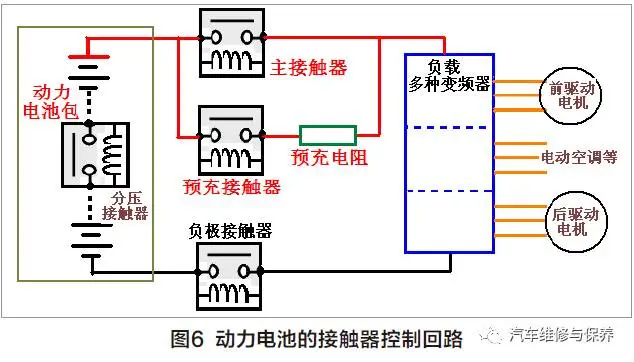
When the voltage of the load capacitor on the motor controller is getting higher and higher, close to the voltage of the power battery, and there is no large current impact, the pre-charge manager will automatically cut off the pre-charge contactor and then turn on main contactor, let the inverter get the full voltage of the power battery, so that it can drive three-phase permanent magnet synchronous motor work normally.
Find out the cause of pre-charge resistance damage, and find that PTC heater is used in the heating element of the car's air conditioner. PTC belongs to the heating element with positive temperature coefficient and consumes a lot of power. Measure that the PTC heating core has been damaged, causing the pre-charge resistance element to be burnt out. After replacing PTC heating core and pre-charging resistance, the test test proves that the failure of the car without electric mode has been eliminated.